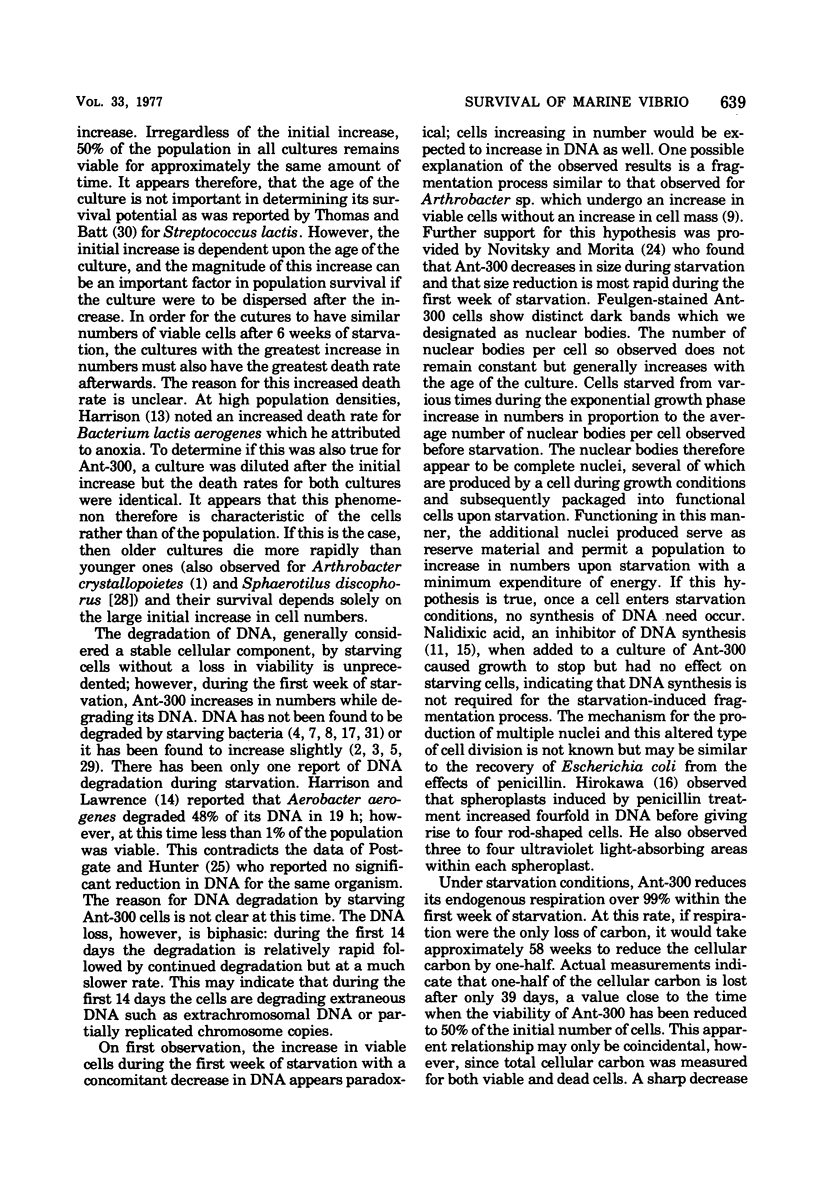Abstract
Ant-300, a psychrophilic marine vibrio isolated from the surface water of the Antarctic convergence, was starved for periods of more than 1 year. During the first week of starvation, cell numbers increased from 100 to 800% of the initial number of cells. Fifty percent of the starved cells remained viable for 6 to 7 weeks while a portion of the population remained viable for more than 1 year. During the first 2 days of starvation, the endogenous respiration of the cells decreased over 80%. After 7 days, respiration had been reduced to 0.0071% total carbon respired per hour and remained constant thereafter. After 6 weeks of starvation, 46% of the cellular deoxyribonucleic acid had been degraded. Observation of the cellular deoxyribonucleic acid with Feulgen staining before starvation showed the average number of nuclear bodies per cell varied from 1.44 to 4.02 depending on the age of the culture. A linear relationship was found between the number of nuclear bodies per cell and the increase in cell numbers upon starvation. Our data suggest that Ant-300 is capable of surviving long periods of time with little or no nutrients and is therefore well adapted for the sparse nutrient conditions of the colder portions of the open ocean.
Full text
PDF






Selected References
These references are in PubMed. This may not be the complete list of references from this article.
- Boylen C. W., Ensign J. C. Intracellular substrates for endogenous metabolism during long-term starvation of rod and spherical cells of Arthrobacter crystallopoietes. J Bacteriol. 1970 Sep;103(3):578–587. doi: 10.1128/jb.103.3.578-587.1970. [DOI] [PMC free article] [PubMed] [Google Scholar]
- Brdar B., Kos E., Drakulić M. Metabolism of nucleic acids and protein in starving bacteria. Nature. 1965 Oct 16;208(5007):303–304. doi: 10.1038/208303a0. [DOI] [PubMed] [Google Scholar]
- Burleigh I. G., Dawes E. A. Studies on the endogenous metabolism and senescence of starved Sarcina lutea. Biochem J. 1967 Jan;102(1):236–250. doi: 10.1042/bj1020236. [DOI] [PMC free article] [PubMed] [Google Scholar]
- CAMPBELL J. J., GRONLUND A. F., DUNCAN M. G. Endogenous metabolism of Pseudomonas. Ann N Y Acad Sci. 1963 Jan 21;102:669–677. doi: 10.1111/j.1749-6632.1963.tb13667.x. [DOI] [PubMed] [Google Scholar]
- DAWES E. A., HOLMS W. H. Metabolism of Sarcina lutea. III. Endogenous metabolism. Biochim Biophys Acta. 1958 Nov;30(2):278–293. doi: 10.1016/0006-3002(58)90052-0. [DOI] [PubMed] [Google Scholar]
- DAWES E. A., RIBBONS D. W. SOME ASPECTS OF THE ENDOGENOUS METABOLISM OF BACTERIA. Bacteriol Rev. 1964 Jun;28:126–149. doi: 10.1128/br.28.2.126-149.1964. [DOI] [PMC free article] [PubMed] [Google Scholar]
- Dawes E. A., Large P. J. Effect of starvation on the viability and cellular constituents of Zymomonas anaerobia and Zymomonas mobilis. J Gen Microbiol. 1970 Jan;60(1):31–42. doi: 10.1099/00221287-60-1-31. [DOI] [PubMed] [Google Scholar]
- Ensign J. C. Long-term starvation survival of rod and spherical cells of Arthrobacter crystallopoietes. J Bacteriol. 1970 Sep;103(3):569–577. doi: 10.1128/jb.103.3.569-577.1970. [DOI] [PMC free article] [PubMed] [Google Scholar]
- GOSS W. A., DEITZ W. H., COOK T. M. MECHANISM OF ACTION OF NALIDIXIC ACID ON ESCHERICHIA COLI.II. INHIBITION OF DEOXYRIBONUCLEIC ACID SYNTHESIS. J Bacteriol. 1965 Apr;89:1068–1074. doi: 10.1128/jb.89.4.1068-1074.1965. [DOI] [PMC free article] [PubMed] [Google Scholar]
- HALVORSON H. Intracellular protein and nucleic acid turnover in resting yeast cells. Biochim Biophys Acta. 1958 Feb;27(2):255–266. doi: 10.1016/0006-3002(58)90332-9. [DOI] [PubMed] [Google Scholar]
- HARRISON A. P., Jr, LAWRENCE F. R. PHENOTYPIC, GENOTYPIC, AND CHEMICAL CHANGES IN STARVING POPULATIONS OF AEROBACTER AEROGENES. J Bacteriol. 1963 Apr;85:742–750. doi: 10.1128/jb.85.4.742-750.1963. [DOI] [PMC free article] [PubMed] [Google Scholar]
- HIROKAWA H. Biochemical and cytological observations during the reversing process from spheroplasts to rod-form cells in Escherichia coli. J Bacteriol. 1962 Dec;84:1161–1168. doi: 10.1128/jb.84.6.1161-1168.1962. [DOI] [PMC free article] [PubMed] [Google Scholar]
- HOLDEN J. T. Degradation of intracellular nucleic acid and leakage of fragments by Lactobacillus arabinosus. Biochim Biophys Acta. 1958 Sep;29(3):667–668. doi: 10.1016/0006-3002(58)90041-6. [DOI] [PubMed] [Google Scholar]
- Helmstetter C. E., Pierucci O. Cell division during inhibition of deoxyribonucleic acid synthesis in Escherichia coli. J Bacteriol. 1968 May;95(5):1627–1633. doi: 10.1128/jb.95.5.1627-1633.1968. [DOI] [PMC free article] [PubMed] [Google Scholar]
- MANDELSTAM J. Turnover of protein in growing and non-growing populations of Escherichia coli. Biochem J. 1958 May;69(1):110–119. doi: 10.1042/bj0690110. [DOI] [PMC free article] [PubMed] [Google Scholar]
- Novitsky J. A., Morita R. Y. Morphological characterization of small cells resulting from nutrient starvation of a psychrophilic marine vibrio. Appl Environ Microbiol. 1976 Oct;32(4):617–622. doi: 10.1128/aem.32.4.617-622.1976. [DOI] [PMC free article] [PubMed] [Google Scholar]
- POSTGATE J. R., HUNTER J. R. The survival of starved bacteria. J Gen Microbiol. 1962 Oct;29:233–263. doi: 10.1099/00221287-29-2-233. [DOI] [PubMed] [Google Scholar]
- STRANGE R. E., WADE H. E., NESS A. G. The catabolism of proteins and nucleic acids in starved Aerobacter aerogenes. Biochem J. 1963 Feb;86:197–203. doi: 10.1042/bj0860197. [DOI] [PMC free article] [PubMed] [Google Scholar]
- Stokes J. L., Parson W. L. Role of poly-beta-hydroxybutyrate in survival of Sphaerotilus discophorus during starvation. Can J Microbiol. 1968 Jul;14(7):785–789. doi: 10.1139/m68-130. [DOI] [PubMed] [Google Scholar]
- Thomas T. D., Batt R. D. Degradation of cell constituents by starved Streptococcus lactis in relation to survival. J Gen Microbiol. 1969 Nov;58(3):347–362. doi: 10.1099/00221287-58-3-347. [DOI] [PubMed] [Google Scholar]
- Thomas T. D., Batt R. D. Survival of Streptococcus lactis in starvation conditions. J Gen Microbiol. 1968 Mar;50(3):367–382. doi: 10.1099/00221287-50-3-367. [DOI] [PubMed] [Google Scholar]


